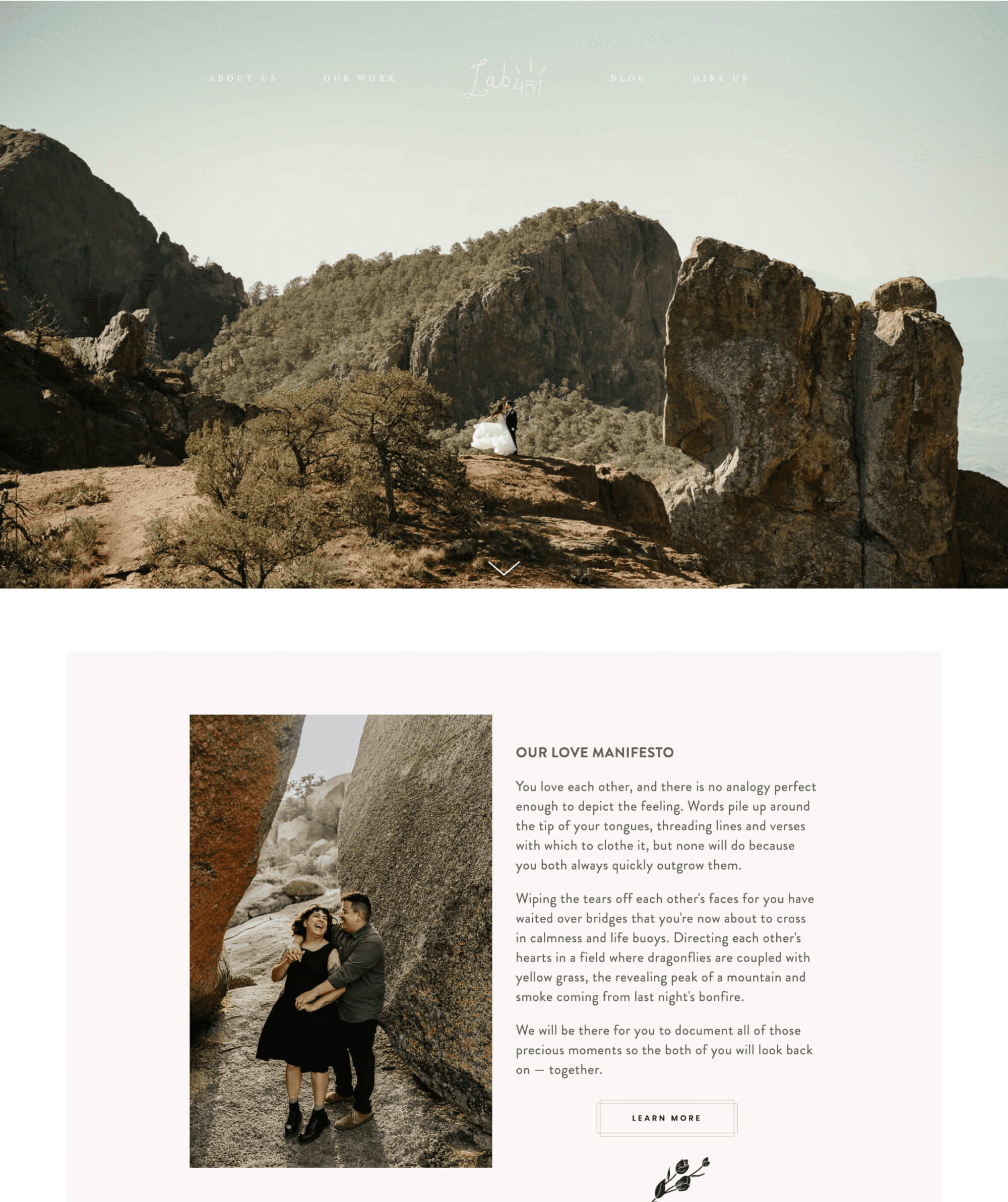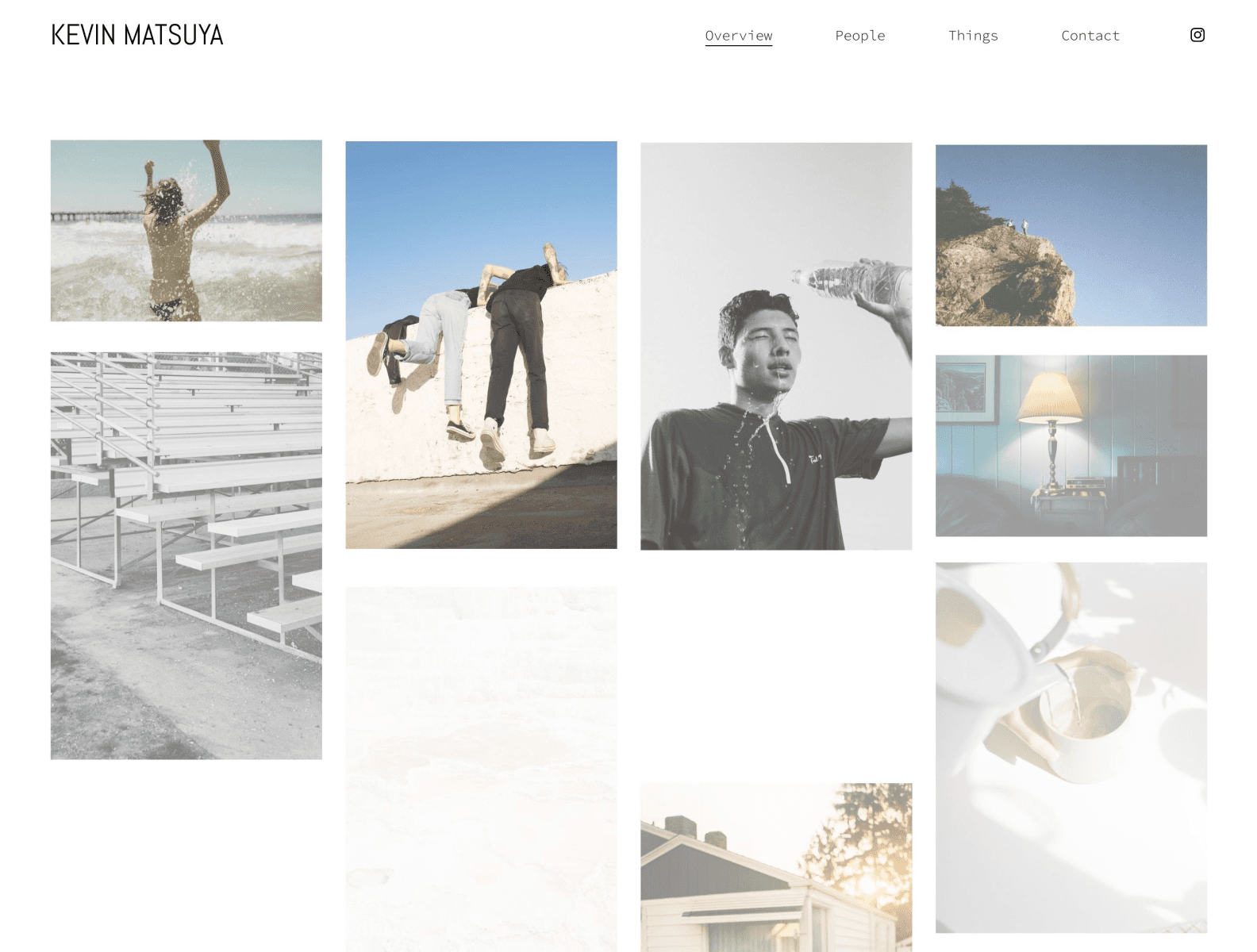

Akim Perminov
Certified Squarespace expert
14 Striking Squarespace Portfolio Templates [2024]
When building a portfolio online, Squarespace offers a variety of templates to showcase your work in the best light. Whether you're a designer, photographer, or artist, finding the right template is key to highlighting your skills and projects.
The best Squarespace portfolio templates combine clean design with powerful features. These make it easy for visitors to navigate and appreciate your work.
Choosing the right template can make a big difference in how potential clients or collaborators perceive your portfolio.
It’s important to look for templates that offer customizable layouts to fit your unique style and projects.
Templates with built-in features like image sliders, video backgrounds, and interactive galleries can enhance the visual experience.
To help you make the best choice, this blog post explores top templates specifically designed for various professional needs.
Some templates excel for photography portfolios, while others are perfect for art or design portfolios. This guide will also provide tips for optimizing your chosen template to reflect your personal brand.
Key Takeaways
Choose templates that fit your style and professional needs.
Look for templates with strong built-in features for better presentation.
Optimize your template to enhance your personal brand.
1. Palette by Oneforme

Unveil your creative prowess with our Palette, the Squarespace template that turns your portfolio into a captivating showcase of talent. Designed for creative professionals across various disciplines, Palette offers a versatile platform to display your work with style and sophistication.
Palette's minimalist design creates the perfect backdrop for your projects, allowing your creativity to take center stage.
Its intuitive layout guides visitors through your portfolio with effortless grace, ensuring your work makes a lasting impression.
Key features for portfolio websites:
Customizable grid layouts to display diverse project types
Detailed project pages for in-depth case studies
Responsive design that adapts to all devices, showcasing your work flawlessly
Whether you're a photographer, designer, artist, or multi-disciplinary creative, Palette adapts to your unique style. The template's clean aesthetic and user-friendly interface make it easy to update your portfolio, highlight your creative process, and attract potential clients or collaborators.
With Palette, you're not just creating a portfolio – you're crafting an immersive online experience that captures the essence of your creative vision. It's the ideal platform to showcase your best work, tell your professional story, and leave a lasting impression on anyone who visits your site.
2. Ruminant by Kate Scott

The Ruminant template, inspired by the popular Brine family of templates on Squarespace, serves service providers and course creators well. This template can benefit photographers looking to expand their offerings to include photography courses and consulting.
Additionally, it can be adapted to sell prints via a print-on-demand service or merchandise through an online shop. Its flexibility makes it suitable for various purposes beyond its initial design. As one of the most versatile core templates in the Squarespace library, Ruminant provides many options for customization and diverse applications.
3. Elysian by Britta Made

Elysian is a dynamic template perfect for artists who wish to highlight their personality along with their work. Its design is bold and slightly aggressive, capturing attention quickly.
The blog is seamlessly integrated, making it ideal for activists or storytellers. The modern layout can be customized easily by changing colors, fonts, and backgrounds. This flexibility allows users to tailor the aesthetic to their personal style, ensuring their site stands out while still reflecting their unique vision.
4. Fiji by SquareMuse

Fiji by SquareMuse features a traditional portfolio style with a grid-based display for the homepage. This layout provides ample space to showcase art or photos, as well as deeper spaces for blog posts and other text content.
The template is professional and elegant, making it especially useful for photography businesses. Though it has a few limitations, it doesn’t offer many additional freebies compared to other companies. Despite this, Fiji uses a robust installation tool that simplifies tweaking a Squarespace site.
Fiji is ideal for visual artists looking to set up small businesses. It is both a reliable and user-friendly choice.
5. Clean Freak by 23&9 Creative

This option is visually appealing, focusing on a creative layout with images. There's ample space to add text that complements the visuals. It includes valuable extras: an SEO guide, access to editable Canva files for customization, and additional resources to enhance your project.
Like other templates on the list, it is mobile responsive, ensuring a seamless user experience across devices.
Features:
Creative image-focused design
Ample text space
SEO guide included
Editable Canva base files
Mobile responsive
6. Victoria by Big Cat Creative

Victoria offers a bold and clean southwestern, retro-inspired design. It features a lot of blank space, allowing each element to stand out on its own. This helps to draw attention to specific pieces.
Big Cat Creative provides an unusual design approach. Instead of ready-to-use templates, they supply elements, code snippets, and guides. This enables users to customize their templates easily.
For those who are comfortable with a bit of DIY, Leon can be a favorable option. However, it's essential to be prepared for some effort to achieve the desired look.
7. Balboa by Squarespace (7.1)

Balboa is one of the templates that Squarespace offers. Many websites use these default templates, leading to a sense of sameness among different sites. This can make the sites feel less unique, especially for artists who want to show creativity.
Balboa is still a good choice but be aware that visitors might recognize it from other sites. This recognition could make your work seem less original to potential clients or fans.
Features of Balboa:
Offered by Squarespace: Easy integration and use
Creative Design: Suitable for artists, though not unique
Risk of Similarity: Common among other websites
This reduces the template’s impact, which is important to consider when choosing it for your project.
8. GoLive's Easton

Easton is ideal for individuals focusing on a personal brand. It highlights the person instead of their work, making it perfect for those promoting themselves online.
This template is especially useful for freelancers building a brand. Multimedia elements are prominently featured, ensuring the individual stays centered.
Limitations:
Not suited for portfolio-style submissions.
Less effective for business card-style websites.
Goals are crucial when choosing this template. The choice hinges on whether one aims to spotlight themselves or their work.
9. Lady Nomad by Station Seven

Lady Nomad blends graphics and minimalism smoothly. It's tailored for those looking to escape the traditional 9-5 job to start a travel, lifestyle, or content creation venture.
This template is ideal for artists aiming to build a personal brand rather than just a simple portfolio.
Features:
Blog Integration: Perfect for keeping a blog updated alongside showcasing art.
Personal Branding: Made for creators who want to highlight their style and personality.
Minimalist Design: Focuses on clean design without overwhelming the viewer.
A solid choice for anyone who wants to mix blogging with a personal touch.
10. Matsuya by Squarespace

Matsuya is a minimalist template from Squarespace. It’s designed to highlight artwork, offering an uncluttered look. The homepage remains simple and clean, featuring very little branding. This template is perfect for artists who prefer their work to take center stage without distractions.
Each piece can have its own detailed page, while the main site stays tidy. Matsuya isn’t focused on SEO, making it ideal for those who prioritize showcasing art over search engine rankings. If more content density with less white space is required, Gates is a suitable alternative from Squarespace’s offerings.
Features:
Minimalist design
Emphasis on artwork
Uncluttered homepage
Limited branding
Alternative:
Gates: Denser layout, less white space.
11. Bombshell by GoLive

Bombshell by GoLive (7.1) is tailored for creatives wanting to showcase services in a small business or freelance setting. The template features a collage-style layout, offering a seamless blend between a portfolio and services display.
This design includes an understated blog section to aid SEO efforts, without dominating the main content. The aesthetic is high-end and eclectic, making it better suited for unique, artistic endeavors like muralists, rather than conventional media or service presentations.
12. Boho Social by Applet Studio

Boho Social is a versatile template available for both Squarespace 7.0 and 7.1. The design remains consistent across both versions.
Squarespace 7.1 tends to offer more flexibility for users wanting to customize their site. In contrast, Squarespace 7.0 may be simpler for those already familiar with the platform.
Originally aimed at small businesses and service providers, this template is adjustable. A few tweaks can make it more suited for art or photography. The level of customization and additional features depends on the user's needs and willingness to employ plugins and code snippets.
13. Atelier by Candor

Atelier by Candor (7.1) is a visually rich template that was initially designed for small businesses. Despite its business-oriented origins, it serves artists and designers well, especially those interested in selling prints, merchandise, and other products showcasing their art.
This template offers flexibility and is an excellent starting point for creative professionals aiming to present and sell their work online.
Key Features
Highly Visual Design
Adaptable for Various Uses
Perfect for Selling Artistic Products
This versatile template can be tailored to meet the unique needs of any artist or designer.
14. Marigold by Studio Mesa

Marigold is built on the versatile 7.1 base template, making it a stylish choice for artists. This dark and sleek theme is especially popular among boudoir photographers, who appreciate its intimate feel. Wedding photographers also find it suits their needs well.
With some adjustments, it can adapt to travel photography and graphic design. To use Marigold effectively, a Squarespace business plan is necessary.
Benefits:
Elegant and dark design
Suitable for intimate photography
Considerations:
Requires a Squarespace business plan
Choosing the Right Squarespace Template
Choosing a Squarespace template for your portfolio site involves understanding Squarespace's platform, the features and flexibility of different templates, and the importance of design and user experience.
Each aspect plays a crucial role in how your portfolio will be perceived.
Understanding Squarespace's Platform
Squarespace is a popular website builder known for its sleek designs and ease of use. It offers a variety of templates specifically designed for portfolio sites.
The platform allows users to customize templates without needing advanced design skills. This means you can achieve a professional look even if you're not a designer.
It also integrates well with different multimedia elements which is ideal for showcasing work in various formats.
Template Features and Flexibility
Each template on Squarespace comes with distinct features. Some templates might emphasize large, high-quality visuals, while others may focus on text and intricate design elements.
When choosing a template, consider the type of content you will showcase.
Do you need a large image gallery? Or perhaps a blog section for detailed project descriptions?
Ensure the template you select can accommodate these needs without feeling cluttered.
Flexibility is key. A good template should allow you to add or remove sections and adjust layouts easily.
This helps in keeping the website updated and aligned with your evolving portfolio.
Importance of Design and User Experience
Design and user experience are critical for making a lasting impression. A modern look can attract visitors, but if the site is hard to navigate, they might leave quickly.
Choose a template with clean lines and an easy-to-navigate structure.
Look for features like intuitive menus, clear calls to action, and responsive design that adjusts well whether viewed on a desktop or a mobile device.
A well-designed template not only looks good but also enhances the user experience, making it easier for visitors to find and appreciate your work.
Must-have Features in Portfolio Templates
When choosing a portfolio template, it's important to focus on key features that enhance both functionality and aesthetics. These include presentation options, social media integration, and customizable elements.
Gallery and Slideshow Options
A good portfolio template should offer multiple gallery styles and slideshow options.
Look for templates that include masonry grids, full-width images, and lightbox effects. This flexibility allows the user to display images in a visually appealing way.
Slideshow options should include automatic transitions and manual controls. This helps to keep viewers engaged while they explore the gallery.
High-quality image handling is crucial for showcasing work in the best light.
Well-designed galleries can significantly boost the visual impact of the portfolio, making it more attractive to potential clients.
Social Media Integration
Templates should seamlessly integrate with social media platforms like Instagram, Facebook, and Pinterest.
This allows users to automatically pull in feeds or share content easily, keeping the portfolio dynamic and up-to-date.
Look for social media icons that are clearly visible and match the overall design. Make sure they link directly to the relevant social media pages.
Integration with Instagram or Pinterest can be particularly effective for visual portfolios.
A smooth social media connection can enhance the portfolio's reach and engagement by driving traffic from various platforms.
Contact Forms and Conversion Elements
Including a contact form is essential for converting visitors into clients.
A well-placed contact form with fields for name, email, and message can make it easy for potential clients to reach out. Make sure the form is simple and user-friendly.
In addition to contact forms, call-to-action (CTA) buttons can significantly increase engagement.
These buttons should prompt visitors to take specific actions like "Book Now" or "Request a Quote."
Placing these elements strategically enhances the chances of converting leads into clients.
Customization and Typography
A portfolio template should offer a wide range of customization options.
This includes the ability to change colors, fonts, and layouts easily. Being able to customize ensures that the portfolio can reflect the individual's personal brand.
Typography is another important aspect. The template should provide a variety of fonts to choose from.
High-quality fonts improve readability and make the portfolio look professional. Google Fonts is a common feature that allows for easy integration of different font styles.
Good customization and typography options make the portfolio look unique and cohesive, aligning with the creator’s vision.
Structuring the Portfolio Page
A well-structured portfolio page includes key sections like the main landing page, showcasing the best work, a personal story in the about section, and testimonials from past clients. These sections help to present one's work, personality, and achievements effectively.
Landing Page and First Impressions
The landing page is where potential clients form their first impressions. It's crucial to use high-quality images and clear text. A bold headline that reflects the designer's persona can catch attention. For example, Christina Hartman uses a clean layout with striking visuals on her landing page.
A strong landing page conveys professionalism. It should have easy navigation, a concise introduction, and a visually appealing design that showcases design skills right from the start.
Highlighting Best Work and Case Studies
This section is the core of the portfolio. Highlight the best work by using high-resolution images and short descriptions. Each project should have its own space, with a focus on design skills and processes. Use case studies to tell stories about key projects, including challenges and solutions.
It's important to show variety in the projects. This demonstrates versatility. Adding a touch of storytelling can engage potential clients, making the work more relatable and impressive.
About Section with Personal Story
The about section should give insight into the designer’s background and persona. It’s a chance to show the personal side by sharing a brief story about their journey. Mentioning key experiences and achievements adds credibility.
Personal stories help build a connection with visitors. Sharing how they got into design, what drives them, and their design philosophy can make them more relatable and trustworthy.
Testimonials and Past Clients
Testimonials provide social proof and build trust. Including quotes from past clients who were satisfied with the work adds credibility. For instance, a testimonial from a well-known client can make a big difference.
List some past clients to showcase experience and range. Even brief testimonials, if well-placed, can create a strong impact. They show that the designer has a proven track record and satisfied clients, increasing the likelihood of attracting new business.
Integrating Blogs and Additional Content
Integrating a blog into your Squarespace portfolio offers great benefits like showcasing your expertise through articles and improving your visibility through SEO.
Showcasing Expertise Through Articles
A blog allows professionals to display their knowledge. Writing on relevant topics shows skills and experience. For example, an interior designer can post about design trends, space planning tips, and favorite materials. These articles can engage visitors and turn them into clients.
Articles also serve as a writing portfolio. For creative professionals, regularly posting quality content demonstrates their ability to communicate ideas effectively. It also enhances the site's overall appeal, making it a go-to resource for informative and engaging stories.
Utilizing a Blog for SEO and Visibility
Search engines favor websites with fresh content. Regular blog posts keep your site updated, which can boost rankings in search results. Writing about popular topics related to your field improves your site's chances of appearing in relevant searches.
Using keywords strategically is essential. Including phrases like "interior design tips" or "writing portfolios" can help attract visitors looking for specific content. Well-crafted headlines and meta descriptions further increase the visibility of your blog, drawing more traffic to your portfolio.
Promoting Your Portfolio
Promoting your portfolio is crucial for increasing visibility and attracting potential clients. Using social media, networking, and direct outreach can significantly boost your online presence and showcase your work to a wider audience.
Effective Use of Social Media
Social media is essential for promoting an online portfolio. Platforms like Instagram allow users to create a visually appealing feed that highlights their best work. They should post regularly to keep followers engaged and use relevant hashtags to reach a broader audience.
Engaging with followers by responding to comments and direct messages can build a loyal community. Collaborating with other creators and influencers can also help amplify their reach. Using stories and live streams adds a personal touch and keeps the audience connected to the artist's journey.
Networking and Online Communities
Networking is key to expanding one's reach. Joining online communities and forums related to their field can lead to valuable connections. Participating in discussions, sharing experiences, and offering advice can establish them as knowledgeable and approachable.
Seeking out virtual events, webinars, and workshops allows for real-time interactions with industry professionals. These opportunities can lead to collaborations and new clients. Being active in these spaces demonstrates a commitment to one's craft and opens doors to being noticed by potential clients.
Direct Outreach to Potential Clients
Direct outreach is a proactive way to promote a portfolio. Researching potential clients and sending personalized emails can make a strong impression. Including a brief introduction, a link to the portfolio, and a few highlights of relevant work can showcase their sophistication and ability to meet the client's needs.
Using a personal touch, like referencing specific projects or needs of the potential client, can make the outreach more effective. Following up with a thank-you note or a gentle reminder if there's no immediate response can keep the door open for future opportunities.
Maintaining and Updating Your Portfolio
Creatives must keep their portfolios updated to stay relevant. Regular refreshes, goal alignment, and feedback are crucial for showcasing current skills and trends.
Regularly Refreshing Content and Designs
Refreshing your portfolio content and designs is essential to catch the eye of potential clients. Update images, projects, or case studies regularly. This keeps the portfolio relevant and showcases the latest work.
Pay attention to current trends. Update your color scheme, categories, and layout to align with modern styles. This shows that you are aware of current design aesthetics.
Portfolio websites should reflect your best work. Regularly filter out outdated or less impressive projects. This keeps your portfolio sharp and professional.
Adapting Portfolio to Evolving Goals
As career goals evolve, so should the portfolio. Adapt it to reflect new skills, roles, and aspirations. This helps potential clients understand your current focus and expertise.
Categorize your projects to highlight different skills. This makes it easier for viewers to find relevant work. For example, divide your projects into web design, branding, or illustration.
Align the portfolio with your professional goals. Adjusting the project descriptions and skills highlighted can make a significant difference in how you are perceived.
Gathering Feedback and Making Improvements
Gathering feedback is key to improving a portfolio. Seek input from peers, mentors, or past clients. Their perspectives can highlight areas needing enhancement.
Implement changes based on feedback. Adjust the layout, improve images, or rewrite descriptions. This iterative process leads to continuous improvement.
Regular updates based on feedback ensure the portfolio stays relevant and attractive. Incorporating suggestions can enhance the overall presentation and effectiveness of your portfolio.
Frequently Asked Questions
Choosing a Squarespace portfolio template requires attention to features, customization options, mobile responsiveness, and the ability to integrate multimedia and e-commerce capabilities.
What features should I look for in a Squarespace template for showcasing a creative portfolio?
Look for templates with clean and modern designs that highlight visual content. Ensure the template supports high-quality images and videos. Good navigation, such as easy-to-use menus, and customizable gallery layouts are also important.
How can I customize a Squarespace portfolio template to make it stand out?
Use the design tools provided by Squarespace to tweak fonts, colors, and layouts. Add personalized content like branded logos, custom images, and text. Experiment with different page layouts to give a unique feel to each section of your portfolio.
Are there any Squarespace templates that cater specifically to photographers?
Yes, there are templates like "Wells" and "Haven" that are tailored for photographers. These templates offer features like full-screen image displays, customizable galleries, and easy organization of photo collections.
What are the options for integrating multimedia content in a Squarespace portfolio site?
Squarespace supports various multimedia formats including images, videos, and audio files. You can embed videos from platforms like YouTube and Vimeo or upload your own. Adding slideshows, galleries, and audio tracks to your portfolio can enrich the viewing experience.
How does template choice affect mobile responsiveness for a Squarespace portfolio?
Most Squarespace templates are designed to be fully responsive, meaning they adjust automatically for different screen sizes. However, some templates may perform better than others on mobile devices. It's important to choose a template that maintains its visual appeal and usability on smaller screens.
Can I use Squarespace's e-commerce features to sell work directly from my portfolio site?
Yes, Squarespace allows integration of e-commerce features within portfolio sites. You can add a store page, set up product listings, and manage inventory.
This way, visitors can view and purchase your work directly through your portfolio.
Find the ideal template with our articles
Oneforme is where you can find the best Squarespace templates for every cause, business or individual. Here are some of our picks to help you find the ideal template:
Best Squarespace template shops
Best Squarespace templates for therapists
Best Squarespace templates for e-commerce
Best Squarespace templates for photographers
Best Squarespace templates for blog
Best Squarespace templates for coaches
Best Squarespace templates for artists
Best Squarespace templates for graphic designers
Best Squarespace templates for newsletter
Best Squarespace templates for Interior designers










